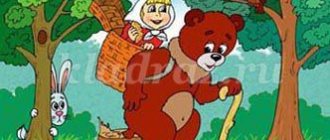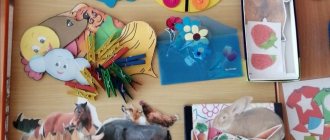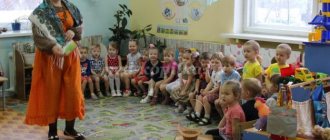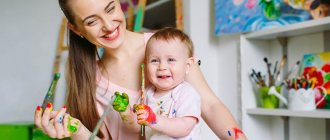Summary of a lesson on sensory development in a nursery group.
| Summary of a lesson on sensory development in a nursery group. |
Topic: "Big - small."
Goals:
Learn to group objects of different sizes (large, small) by adding an object to an object. Develop practical knowledge about the size of objects in the “big-small” ratio; elements of constructive thinking, the ability to understand verbal instructions from an adult, memory, active vocabulary, coordination of small hand movements and visual control.
Program content
: Draw children’s attention to the difference in size of objects, develop an understanding of words - big and small. Encourage children to repeat words, to show large and small objects.
Equipment:
table, 2 toys - dogs, differing in size;
2 houses, 2 bows, 2 balls, 2 plates, 2 “bones” - corresponding in size to the dogs; bubble. Progress of the lesson: 1. Introductory part
. - Guys, who is that barking loudly? Bow-wow. Yes, that’s right, it’s a big dog barking, she came running to visit us. - Who is this who barks so quietly? Bow-wow. Yes, this is also a dog, but a small one. - They came running to us. Show me the big dog. Show me the little dog. (children show). 2. Main part. - Guys, look, there are houses here. Dogs live in them. What kind of house is this? (big). And this one? (small). - What kind of dog is this? (large). Which house will she live in? Show. (in big). - What kind of dog is this? (small). Which house will she live in? Show. (in a small one). - Let's give the dogs bows. Here we have a big and a small bow.
What kind of bow is this? What is this one? (children's answers). — Which dog will we give a big bow to? (big). - Which dog will we give a small bow to? (small); (children can show). - Look how smart our dogs have become. — The big and small dogs were playing with balls and lost them, but I found them, here they are. (showing big and small balls). - These are big and small balls. Show me the big ball. Show me the small ball. — Which dog will we give the big ball to? (children point to the big dog). - What kind of small ball should we give? (point to the small one). Physical education minute.
-Now, guys, stand near the chairs.
Let's jump like dogs and bark. -The dogs liked the way you jumped.
Sit down. Our dogs, big and small, wanted to eat. Let's feed them. -I’ll put out a large and a small plate now. What kind of plate is this? (large). And this? (small). -Which dog should we give the big plate? Show. (point to the big dog). -Shall we give a small plate to which dog? Show. (point to the small one). -We'll treat them to bones. These are large and small bones. What kind of bone is this? (large). Which dog should we give the big bone? Show. -What is this? (small).Which dog will we give a small bone? Show. - Well done. 3. Final part. Result of the lesson: -So we fed the big and small dog. They live in a large and small house, play with large and small balls, eat a large and small bone from a large and small plate, and were given large and small bows. They brought you soap bubbles. Let the dogs watch how you and I catch soap bubbles. Show me big and small bubbles.
Summary of the lesson on sensory education “Big - small”
Summary of the lesson on sensory education “Big - small”
Goals:
Teach children to perceive size (large - small), the ability to relate and distinguish objects by size.
Develop visual perception and attention.
Cultivate interest in the activity and the ability to interact with each other.
Equipment:
toy: Masha and the Bear, 2 sets of children's dishes, 2 blank scarves made of cardboard, multi-colored geometric figures made of paper, glue, 2 Christmas tree toys.
Organizing time
—
Hello guys! We have guests today! (they get Masha and the Bear toys) Let's get to know them.
Introductory conversation
- Look carefully at our guests.
— What can we say about Masha? What about Misha? (the bear is big, and Masha is small)
Didactic game:
"Feed the dolls"
Target:
learn to compare and correlate the sizes of utensils, hold a spoon correctly, cultivate a caring attitude towards utensils, and instill hospitality skills.
- Guys, let's give Masha and Misha a treat.
- Which plate will we give Masha? (small)
- And Misha? (large)
- What spoon will the Bear eat with? (big)
- What kind of napkin is Masha asking for? (small)
- Why is she asking for a small napkin? (because Masha is small)
Fizminutka:
"The Bear and the Hare"
The bear has a big house, (spread your arms to the sides)
And the hare’s is small (put your hands together)
Our bear went home (imitate the gait of a bear)
And behind him comes the bunny (hands on the belt, jumping)
.
A game:
"Who has what clothes"
Target:
learn to use diminutive forms of words in speech, differentiate the sizes of clothing items.
—
The guys, getting ready to visit us, Masha and Misha dressed up. Look how beautiful their clothes are!
—
Masha really likes it when her clothes are praised. Let's please her and improve her mood.
Each child must name one thing (accessory) of the doll.
- What a bright blouse Masha has! Let's describe it. (yellow, small, soft)
— Bear has a large pocket on his jacket, but what kind of pocket does Masha have? (small)
Application:
"Scarves"
—
Guys, our guests brought scarves with them. Look what color they are? (white)
—
Masha and Misha ask you to decorate the scarves, make them bright and beautiful. Let's help them.
—
I have these figures, large and small.
—
We will glue small figures onto Masha’s scarf, and large ones onto Misha’s scarf.
Children glue multi-colored geometric shapes onto scarves in a chaotic manner.
— What colorful scarves you made. Our guests are very happy!
Bottom line
— Guys, it’s time for our guests to go home. They really enjoyed playing with you and say “thank you” for your hospitality. What did you like most today?
Lesson on sensory development in the first junior group “Toys”
Sensory development session
in the first junior group
"Toys"
Educator: Sabirova E. A.
Target:
Continue to teach children to distinguish and name colors: red, blue, green, yellow, black, white; perceive and distinguish shades. To consolidate the ability to recite a poem, clearly pronouncing the words, to form an idea of the shape of an object: round, square. develop attention, independence, cultivate kindness, an emotionally positive attitude towards the characters.
Material:
toys - horse, hare, fox, cart, clothespins; box, colorful hares and sheets of paper..
Organization of the lesson:
children sit in a semicircle on the carpet.
Preliminary work:
memorizing poems by A. Barto.
Methodical techniques:
surprise moment, games, questions for children, productive activities of children.
Progress of the lesson.
The teacher listens: “Who is coming to us?” The children look around. (A horse and cart enters.)
- Children, who came to us?
- Who knows a poem about a horse?
The teacher calls two children, offers to pet the horse and recite a poem, and monitors the clarity of the pronunciation of the words. If the other children also show a desire, then they tell everything together in chorus.
-The horse is very happy that the children take such care of it. That's how happy she is (the horse neighs). She brought you a large beautiful box as a gift, and there are many colorful boxes in it. (The teacher puts them on the table).
- Children, each take a box for yourself. What color are they?
-Oh, there’s something else in the box (he throws clothespins onto the carpet).
- Children, I accidentally scattered them, please help me collect them. The horse asks you to attach the clothespins to the box correctly. Blue clothespins on a blue box, and yellow ones on—? (yellow).
(Children collect and pinch).
-Thank you, kids. Now let's show that we can walk and gallop like horses. We will walk to the slow knock of the tambourine, raising our knees high, and to the fast knock, we will jump. (Physical training is held).
-Children, sit down and relax. The horse really enjoyed playing with you. But someone is scratching in the cart. (Takes out the bunny). The bunny also wants to play with you. Oh, he's all wet. Help the bunny, wipe him with a towel. (Children wipe). The owner forgot the bunny in the rain. Is it possible to leave toys in the rain? Who wants to console the bunny and tell him a poem about him? (The teacher asks two children, monitors their speech).
-The bunny liked visiting the kids so much that he even invited his little bunnie friends to visit. (The teacher places bunnies of different colors in front of the children and invites each child to take one bunny).
-Children, what color are your bunnies? (Children call). The horse told me that a sly fox was walking somewhere nearby. She wants to catch bunnies. Let's hide them in the clearings. (Points to multi-colored round and square sheets of cardboard).
-Look, in which clearing the fox will not notice the red bunny, the red one or the green one? This means we need to hide the bunny in a clearing of the same color as the bunny itself. (The children hide the bunnies, and the teacher looks for them with a toy fox.)
-Children, the horse is calling us to him. While you were hiding the bunnies, she brought a treat - candy. Help yourself, please, and give the fox a treat. What should you tell the horse? (Children thank the horse and say goodbye).
Bibliography:
Education and training program in kindergarten. Vasilyeva M.A., Gerbova V.V., Komarova T.
Complex classes in the first junior group of kindergarten. Bondorenko T. M.






